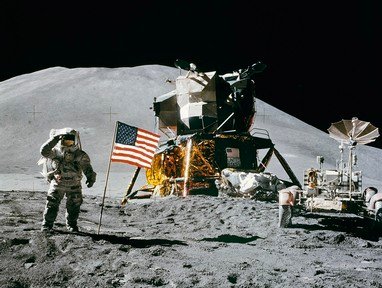Quiz Answer Key and Fun Facts
1. This command module orbited the moon with Michael Collins while Neil Armstrong and Buzz Aldrin walked on the moon. Which was it?
2. The namesake for the Apollo 12 command module is actually depicted in the mission patch. What is its name?
3. This lunar module from Apollo 13 never landed on the moon, though its use as a "lifeboat" saved the lives of its crew.
4. As the first American in space, albeit in a suborbital flight, it is fair to say that Apollo 14 commander Alan Shepard knows a bit about first flights. It's not surprising, then, that this was the name of the Apollo 14 command module.
5. During a telecast to schoolchildren from the surface of the moon, commander Dave Scott proves Galileo's theory of gravity and mass, by dropping a feather from this bird at the same time as a hammer, both of which fall slowly in the moon's 1/6 gravity and land at the same time. The name of the lunar module shares the same name as this bird who gave up the feather
6. As the first expanded science mission to the moon, Apollo 15 named its command module "Endeavour" after the ship sailed by this famous 18th century explorer.
7. Apollo 16's lunar module is the only US manned spacecraft named for a constellation. What was its name?
8. Like Apollo 11, Apollo 17, the last of the moon landings, had as its command module another patriotic name. What was it?
9. In addition to the Apollo 13 lunar module, there were two other manned lunar module flights which flew in space but did not land on the moon. What were their names?
10. Three space shuttles shared their name with either a lunar module or command module from the Apollo flights. Which three are they?
Source: Author
kimaanja
This quiz was reviewed by FunTrivia editor
bloomsby before going online.
Any errors found in FunTrivia content are routinely corrected through our feedback system.


